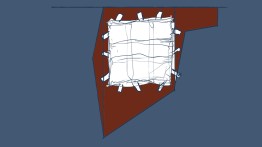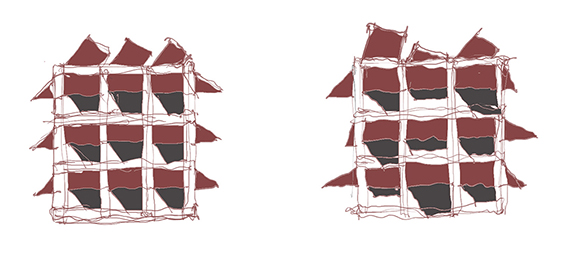Anders Abraham AR'91: 16-8
POSTED ON: September 16, 2022

This project—16-8: Various Things of Different Sizes–A Grid of (no) Ideas—by Anders Abraham AR'91 is drawn from At the Intersection of Ideas and Material Conditions, a Third Floor Hallway Gallery exhibition showcasing work by architects, researchers, and teachers at the Royal Danish Academy. The exhibition is part of an ongoing dialogue between faculty and students of The Irwin S. Chanin School of Architecture and the Institute of Architecture and Culture at the Royal Danish Academy. Faculty work from both schools was recently shown in Practices of Risk, Control, and Productive Failure, an exhibition held at the Brønshøj Water Tower in Copenhagen, Denmark from May 17 to June 10, 2022.
A gallery of images from Abraham's 16-8 project can be viewed here, and he described his project as follows:
…by nature, the grid is abstract, and when, for example, Le Corbusier used it in the beginning of the twentieth century it implied a strong ideological positioning: the grid started in ideological opposition to the historical context. New technology originating from early industrial building systems created the floor plate-column construction which, throughout the twentieth century, became the most dominant construction form in the world. In the same period, city centers, in particular, developed with a high degree of complexity—becoming a new nature—with increasing levels of infrastructure, density, and heterogeneity.
Today the grid is no longer in distinct opposition to the historical—we experience the same buildings in Ørestaden, Tokyo, New York, and Beijing. In the rapidly growing city, urban space and building interiors are alike-but-different.
The grid creates a placelessness! The pure grid creates an ideal condition which deletes all local traces: spaces are so alike that the site is transformed from a specific locality to a non-place.
Concrete building systems have developed from being specific, like the Hennebique system, to being anonymous and non-specific. Construction is independent of design, and architecture becomes a curtain wall of tiles or a wallpaper of glass. The grid no longer has an ideological dimension; it is pure pragmatism. In a modern concrete building system, all differences have been eliminated—it is a rationalized version, an anti-vision!
From Abstraction to Figure:
Compared to the complexity of the world, the grid is too simple. By introducing building components that create alternative directions in the grid, a space emerges which is autonomous. It is not a universal condition—and that is its strength and potential! Its different elements create local spaces—bushy clusters—which do not point to an order x, y, z, but to a more heterogenous field. It is not about introducing a systematics of creating differences, but instead adding complexity to something simple. All parts are different but alike—the elements are the same, but different enough to be specific.
Text excerpted from Notes on Various Things of Different Sizes–A Grid of (no) Ideas. AA, September, 2019 (edited August, 2022).

Anders Abraham, PhD, (1964-2020) was a professor and head of the master’s program in Art and Architecture at the Royal Danish Academy until 2020. Abraham was educated at The Cooper Union for the Advancement of Science and Art in New York and was a scholar-in-residence at the Cranbrook Academy of Art in Michigan. Abraham was cofounder of the artistic research biennial Works+Words in Copenhagen. His work was included in numerous exhibitions in Denmark and abroad, including at the Danish Architecture Center, Copenhagen; The Norwegian Centre for Design and Architecture, Oslo; and the Venice Biennale of Architecture. His selected publications include A New Nature: 9 Architectural Conditions between Liquid and Solid (2015), and Byen, rummet og det faelles (2019).




